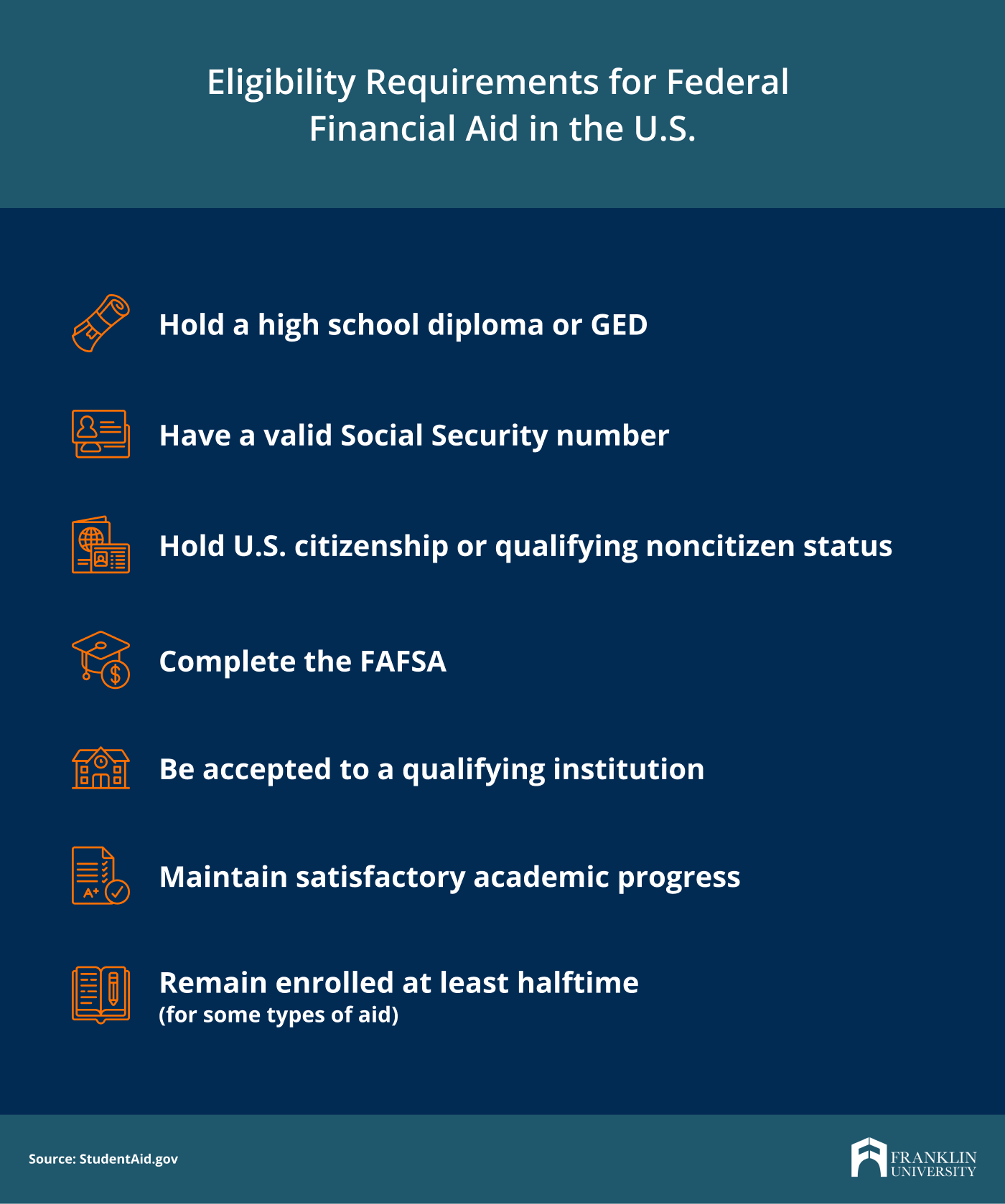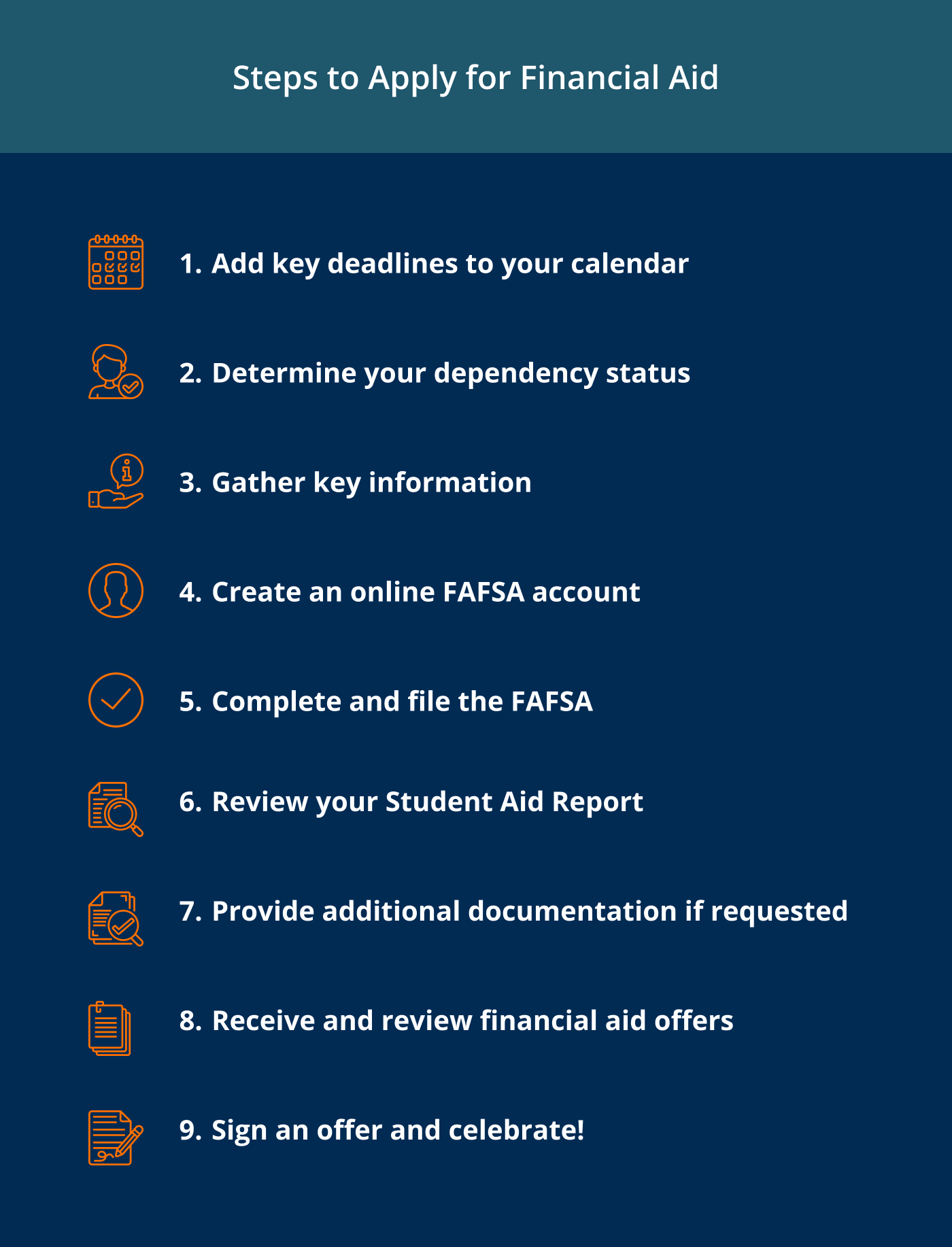Request Information
We're Sorry
There was an unexpected error with the form (your web browser was unable to retrieve some required data from our servers). This kind of error may occur if you have temporarily lost your internet connection. If you're able to verify that your internet connection is stable and the error persists, the Franklin University Help Desk is available to assist you at helpdesk@franklin.edu, 614.947.6682 (local), or 1.866.435.7006 (toll free).
Just a moment while we process your submission.

How to Apply for Financial Aid for College
Are you stressed about navigating the financial aid process?
You’re not alone.
Student loan provider Sallie Mae found that nearly half of the families of college-bound students are unfamiliar with financial aid offer letters, and only 20% feel very prepared to complete the Free Application for Federal Student Aid (FAFSA).
But applying for financial aid is well worth it – and for many students, it makes a college education possible. Here’s how to apply for aid and get meaningful help paying for your degree.
What Is Financial Aid?
Financial aid is outside funding to help you pay for a college degree and for expenses like room and board, textbooks and transportation while you’re a student. The term “financial aid” includes everything from federal, state and private grants to scholarships, student loans and work-study. While some students receive money from employer tuition reimbursement programs or outside scholarships, that funding is generally separate from financial aid.
Financial aid can be need-based (in other words, it’s awarded based on the gap between what college costs and what you can afford to pay) or merit-based (meaning it’s awarded based on factors like your academic performance). Most financial aid is need-based, though some schools also offer merit-based scholarships.
Need-based financial aid funding is allocated to students by their college or university using the FAFSA. Colleges use the information students submit with their FAFSA to identify their eligibility for federal and state aid and calculate the difference between a student’s estimated cost of attendance and what they can afford to contribute.
Who Can Apply for Financial Aid?
Unfortunately, misconceptions about financial aid are widespread. For example, many people assume you need to be a new high school graduate to receive aid. In fact, most prospective undergraduate and graduate degree students qualify for at least some form of financial aid.
According to the College Board, in the 2019-20 school year 75% of public two-year, 78% of public four-year and 88% of private nonprofit four-year first-time full-time undergraduate students received federal, state, or institutional grant aid (money that you don’t pay back). While that data is specific to first-time students, aid is also available to returning students, and there are no age restrictions.
In fact, the qualifications for federal financial aid, according to the U.S. Department of Education, are fairly straightforward. As long as you hold a valid Social Security number; a high school diploma or the equivalent; and U.S. citizenship, green card status or a qualifying visa, you can apply. To actually receive the aid, you will need to both complete the FAFSA and be accepted into an eligible degree program. The amount and type of aid you receive will depend on a number of factors, including your personal financial circumstances.
To maintain your eligibility for aid throughout your time in college, you must remain in good academic standing and make satisfactory progress toward a degree. Certain types of federal aid require recipients to be enrolled at least half-time. Some funding, such as scholarships or grant programs for veterans and their families, comes with additional requirements.

What Is the FAFSA?
FAFSA stands for the Free Application for Federal Student Aid. This application form, which is administered by the U.S. Department of Education, asks for information about your income sources and assets (or your parents’ if you are a dependent student or your spouse’s if you are married). That data is used to determine your eligibility for federal and state governments and loans. You’ll need to fill out the FAFSA every year that you are enrolled to qualify for ongoing aid.
When you complete the FAFSA, you’ll list the colleges or universities that you’re interested in attending. The government shares your information with those schools so they can use it to create a financial aid package to offer to you, which may include federal and state aid as well as institutional aid awards. While some of the financial aid you receive may come from the federal government, it is the schools you are accepted to that offer and administer the funding.
When it comes to paying for school, grants are among your best options. But do you know how to find them? Remove the guesswork by downloading this free guide
What Are the Steps to Apply for Financial Aid?
Applying for financial aid might seem overwhelming, but don’t procrastinate – this is a crucial task to secure your educational and financial future, notes Lea Mederer, director of financial aid processing at Franklin.
“Don’t assume that everything will work out in the end regardless of the effort you put in,” says Mederer. “Waiting until the last minute may result in delays, late fees or losing out on available funding that has deadlines.”
Breaking down the application process into small steps and planning ahead makes it more manageable and gives you the best chance at receiving aid.
Here’s a step-by-step list of tasks to keep you on track.
1. Check FAFSA priority deadlines
While FAFSA applications are accepted on a rolling basis, each school and state sets their own priority deadlines. Applying before these dates will increase your chances of receiving more funding.
2. Determine your dependency status
For college students, dependency status is a legal question that does necessarily relate to whether or not your family offers you financial support.
To be classified as an independent student for financial aid purposes, you must be at least one of the following:
- More than 24 years old
- Married
- A graduate or professional student
- A veteran or member of the armed forces
- An orphan
- A ward of the court
- Someone with legal dependents other than a spouse
- An emancipated minor
- Homeless or at risk of becoming homeless.
If you do not meet at least one of those criteria to be an independent student, you are automatically a dependent student. That means you must also submit your parents’ financial information when applying for financial aid. If you cannot access that information (for example, if you do not know where your parents live, they are incarcerated, or you left home because of abuse), contact your school’s financial aid office right away. In some instances, they may be able to classify you as independent.
3. Gather key documentation
Don’t risk waiting until the last minute and realizing you’re missing an essential form. Collect all the information you need early on, especially if you need records from your parents or a spouse. You’ll need:
- Your Social Security number
- Your driver’s license (if you have one)
- Your most recent federal tax return
- Records of any untaxed income, such as child support
- Documentation of your cash, savings and checking account balances
- Documentation of any investments (including stocks, bonds and real estate outside your primary home). Note that you do not need to submit information about retirement or health savings accounts.
- Documentation of any business assets
- If you are a dependent student, you will also need all that information for your parents. If you are married, you will need your spouse’s tax records.
4. Create a Federal Student Aid (FSA) ID
You’ll need an online account called an FSA ID to file your FAFSA. This ID is used as your legal “signature.” If you are a dependent student, your parent must also create their own. If you are married, your spouse will also need an FSA ID as of the 2024/2025 school year in order to consent to the import of IRS data. It can take a few days for the FSA ID to be matched to your federal records, so it’s best to set it up early. Be sure to enter your names exactly as they appear on your Social Security cards, and don’t lose track of your password.
5. Complete and submit your FAFSA
The U.S. Department of Education recommends completing the FAFSA online for several reasons. Doing so allows you to access the IRS Data Retrieval Tool (DRT), a tool linked within the application that automatically fills in some questions with information from your tax returns. It’s also harder to make a mistake using the online system since you won’t be able to submit your application if certain information is missing. Plus, the application will automatically skip over questions that aren’t relevant to you.
When you complete the FAFSA, you’ll need to include the codes for each school you’re applying to on your application. Doing so allows the government to share your responses with those schools so they can offer you aid. You can find a list of school codes through the Department of Education or by looking at each school’s financial aid page.
Remember to check that you’re using the official government website (ending in .gov) to file your application. The first “F” in FAFSA stands for “free” – any website that asks for payment for the FAFSA is a scam.
6. Review Your Student Aid Report (SAR)
About two weeks after you submit your FAFSA, you’ll receive an email notification that your Student Aid Report is available, and you can access it using your FSA ID. Check it as soon as possible to ensure that there aren’t any errors in your personal information. In addition to correcting errors, this is also an opportunity to update your information if anything has changed since you filed your FAFSA.
Note that the SAR is not an aid offer and will not tell you how much aid you may be eligible for. Instead, it’s an assessment of your potential eligibility that schools use to calculate your aid offers. It will also contain information regarding additional documentation that you may need to submit to your school’s financial aid office.
7. Provide additional documentation if requested
Each year, some students who apply for financial aid are selected for FAFSA verification. If you are selected, your SAR will say so, and you may also receive a letter from your school. This doesn’t mean you did anything wrong – but it may mean you need to supply additional information or tax forms before you can receive aid offers.
8. Receive and review financial aid offers
Once you’re accepted to degree programs that offer financial aid, you will start to receive aid offers from those schools. Timelines vary by school – check your school’s website for details or reach out to their financial aid office if you have concerns.
It’s important to read financial aid offers carefully, since schools may present their packages in different ways. For example, one aid offer may look larger at first glance but contain more loans, while another might offer a higher percentage of grants. Make sure you’re weighing each aid package against that school’s estimated total cost of attendance (which includes things like transportation and books) rather than just tuition.
If something in an aid offer doesn’t make sense or you have questions, don’t hesitate to contact the school’s financial aid office for clarification. They know this process is confusing and want to help you understand your options.
9. Accept an aid offer and finalize documentation
Once you’ve decided which school to attend, and you are happy with the financial aid offer, it’s time to make it official. Sign the offer and follow the school’s instructions to provide any additional documentation. If you are taking out student loans for the first time, you will be asked to sign a legal document called a Master Promissory Note and complete online loan entrance counseling at this time.

Learn More About Franklin’s Affordable Degree Options
Franklin University prioritizes affordability and transparency to help more students access a college education.
When you enroll at Franklin, your tuition rate is locked-in, meaning the price you pay will never increase as long as you remain an active student. Tuition rates are highly competitive, and Franklin’s focus on online education and flexible scheduling options allow you to work while you study to minimize the financial strain of a degree.
Plus, Franklin’s financial aid department works with each student to help them receive all the aid they’re qualified for and offers a streamlined scholarship application process to help you access other sources of aid.
Learn more about financial aid and affordability at Franklin.





